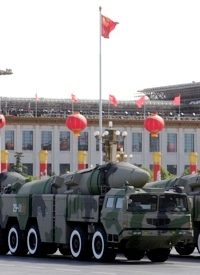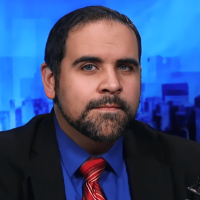
The second half of the 20th century was defined by the military and ideological rivalry between the United States and the Soviet Union. While Russia still maintains a Cold War posture, bearing little difference to its Soviet predecessor, a new Cold War is quickly brewing on the horizon as a new superpower emerges in the East — the People’s Republic of China (PRC).
Despite China’s surface disagreements with Russia and sporadic skirmishes on the Sino-Soviet border, Mao’s Red China was much more diametrically opposed to the United States and the West than to Moscow. KGB defectors such as Anatoliy Golitsyn have exposed the alleged Sino-Soviet split as Moscow’s deception of the West in order to facilitate the Communist world revolution.
China and the New World Order
Today, China having cemented strong economic and military alliances in regional agreements such as the Shanghai Cooperation Organization (SCO), any traces of a divide between Moscow and Beijing are nonexistent. The only difference recently is the PRC’s assertiveness and uncontainable ambition for global hegemony; in essence, China is seeking a leadership role in the new world order.
The first mention of a new world order with the PRC was on February 25, 1972, in a speech by President Richard Nixon at a banquet honoring Chinese Premier Chou En-lai, in which Nixon observed:
You [Premier Chou En-lai] believe deeply in your system, and we believe just as deeply in our system. It is not our common beliefs that have brought us together here, but our common interests and our common hopes, the interest that each of us has to maintain our independence and the security of our peoples and the hope that each of us has to build a new world order in which nations and peoples with different systems and different values can live together in peace, respecting one another while disagreeing with one another, letting history rather than the battlefield be the judge of their different ideas. [Emphasis added.]
The vision of a multipolar world order led by the United States and China, as well as the Soviet Union, Western Europe, and Japan, was the brainchild of President Nixon’s National Security Advisor and subsequent Secretary of State, Henry Kissinger, who admitted as much in his 1979 memoirs White House Years.
The true nature of this new international arrangement was not just one of benign containment through “peaceful” coexistence; instead, its planners envisioned that it and even society would be modeled on that of the Maoist Chinese system. The revelation came from David Rockefeller in a New York Times article dated August 8, 1973:
One is impressed immediately by the sense of national harmony [in China]. From the loud patriotic music at the border onward, there is a very real and pervasive dedication to Chairman Mao and Maoist principles. Whatever the price of the Chinese Revolution, it has obviously succeeded not only in producing more efficient and dedicated administration, but also in fostering high morale and community of purpose.
The price of Mao’s Chinese Revolution is the murder of an estimated 65 million people, according to The Black Book of Communism. These vast fatalities do not sway Rockefeller’s high regard for Mao and his China, as he further states:
The social experiment in China under Chairman Mao’s leadership is one of the most important and successful in human history. How extensively China opens up and how the world interprets and reacts to the social innovations is certain to have a profound impact on the future of many nations.
It is clear from the point of view of establishment insiders such as Nixon, Kissinger and Rockefeller that the PRC’s role in the future of their new world order is not to be underestimated. In an attempt to assure its place in the coming order, the Communist regime in Beijing is beginning to assert itself more and more.
This past September, the PRC deployed its People’s Liberation Army (PLA) forces outside its borders to the Matybulak military base, near Gvardeisky in Kazakhstan, as part of the SCO’s “Peace Mission 2010” annual military exercises.
China’s Preemptive Nuclear Strike Policy
China’s PLA ground forces are asserting themselves to be an international force; however this is not the most alarming sign of the PRC’s rise. On January 5, 2011, Japan’s Kyodo News reported that the PRC’s “military eyes preemptive nuclear attack in event of crisis.”
According to the article, “The Chinese military will consider launching a preemptive nuclear strike if the country finds itself faced with a critical situation in a war with another nuclear state,” such as the United States.
According to documents obtained by Kyodo News, the PLA’s strategic missile forces, the Second Artillery Corps, “will adjust the nuclear threat policy if a nuclear missile-possessing country carries out a series of air strikes against key strategic targets in our country with absolutely superior conventional weapons.”
Akio Takahara, a professor of contemporary Chinese politics at the University of Tokyo’s Graduate School of Public Policy, commented about the news of leaked Chinese documents:
It is uncertain whether such policy adjustment represents a policy shift or has been in existence from before, but a preemptive strike as assumed (in the documents) would apply to an extreme situation such as war with the United States, and that is almost inconceivable today. I think [Chinese] President Hu is aware of that.
The PLA calls its preemptive nuclear policy “lowering the threshold of nuclear threats,” which is a cryptic reminder of Chinese Major General Zhu Chenghu’s warning to the United States, in the summer of 2005: “We Chinese will prepare ourselves for the destruction of all of the cities east of Xian [in central China]. Of course the Americans will have to be prepared that hundreds … of cities will be destroyed by the Chinese.”
Following General Zhu’s remarks, the ruling Chinese Communist Party (CCP) quickly changed its tune of a “no-first-strike” policy; however, the news of PRC’s new preemptive policy suggests that either it has shifted policy, or the opposite — that no policy has changed, which would mean that the “no-first-strike” policy was a lie intended to deceive the United States and the West.
If the latter is true, then the PRC’s recent military buildup should at least raise a few eyebrows of concern when considering China’s newly-announced preemptive nuclear first-strike policy.
Buildup or Arms Race?
China’s military buildup is nothing new and should come as no surprise to those who have kept a watchful eye; however, the armaments by which the PRC and the PLA choose to build up is sufficient reason to ring the alarm.
In addition to the PRC’s strategic nuclear forces, the PLA Air Force is also making preparations for what could be a first-strike or stealth-strike. Last week photos surfaced of China’s prototype Chengdu J20 stealth fighter jet, which is meant to rival the United States’ F22 stealth fighter.
The United States has maintained a monopoly in stealth fighters, being the only country in the world to have such in its military arsenal. The very construction and possession of such a stealth fighter by the PRC suggest that it is seriously considering participating in military excursions beyond its borders.
A stealth fighter is not a defensive aircraft; it is an instrument of external operations. Clearly, the PRC is not building stealth fighters to evade its own detection, but rather that of its rivals or enemies — the United States and Taiwan.
Taiwan, according to an article from the Agence France-Presse, via MSN News on January 7, expressed concern over China’s J20 stealth fighter. Taiwanese defense ministry spokesman Yu Sy-Tue responded to the J20, stating, “We are watching the situation closely and continue to gather relevant information,” further telling reporters that “Taiwan needs to strengthen its aerial defense due to a growing imbalance between the two sides.”
With regard to the J20, on January 5 the Deputy Chief of Naval Operations for Information Dominance, which also includes Naval Intelligence, stated: “The Chinese know the importance of developing an indigenous commercial and military aircraft design industry…. The employment of this fighter in numbers will be both a qualitative and quantitative improvement.”
The statement from the Navy added that the “recently photographed J20 prototype appears to be this aircraft, given its developmental status.”
Although the statement claimed that the Navy does not “expect it to be operationally fielded for some time,” the leak of the photos of this stealth fighter has nevertheless come as a surprise to defense analyst and experts in Washington whom estimated that it was far from the developmental stage.
Now that the PLA’s J20 has evaded U.S. developmental predictions it is left to be seen whether it can evade U.S. radar detection – as have many Chinese nuclear ballistic submarines in recent years, coming within distances to close for comfort to U.S. Nimitz-class aircraft carriers.
With regard to aircraft carriers, the U.S. 7th Fleet will no longer be alone, as it will have to share the Pacific Ocean with not only China’s ballistic submarines but also its first fully operational aircraft carrier.
On December 23, 2010, Reuters reported that “China may be ready to launch its first aircraft carrier in 2011.”
According to Reuters, “Analysts expect China to use its first operational aircraft carrier to ensure the security of its oil supply route through the Indian Ocean and near the disputed Spratly Islands, but full capability is still some years away.” However, the very deployment of an aircraft carrier is considered today as a symbol of great nation status, having replaced the battleship as the premier capital surface naval ship.
A “source with ties to the [Chinese] leadership” told Reuters, “The period around July 1 next year to celebrate the [Chinese Communist] Party’s birthday is one window [for launch].”
The carrier to be deployed is believed to be the former Soviet aircraft carrier Varyag, which was towed to the PRC in 2000 and, according to the U.S. Office of Naval Intelligence, is estimated to “be launched as a training platform by 2012,” reported Reuters.
Reuters also noted that “China will have an operational domestically built carrier after 2015.”
Either this year or next, the Varyag will be launched, likely in preparation to train its PLA Navy (PLAN) sailors to man its future fleet of domestically built 50-60,000-ton aircraft carriers projected to come into service in 2015.
By such time, the PLAN will have a total of three operational aircraft carriers and be in a better position to counter the United States’ naval presence in the region, which it views as a threat considering the U.S. commitment to defend Taiwan.
From announcing a policy of nuclear first-strike to nearing the deployment of the J20 stealth fighter and the Varyag aircraft carrier, the PRC’s provocative actions are indicative of a Cold War-style arms race.
If such is the PRC’s intentions, then the question is why? The PLA, unlike the armed forces of other countries, is actually the property of the Communist Party and not the state.
The Chinese Communist Party governs the PRC and owns the PLA, and the actions of the latter two are reflective of the objectives of the CCP. This is the same CCP that Rockefeller exalted as a model for the emerging new world order, in which the PRC intends to play a central role — challenging U.S. hegemony in the process.
Photo: In this Oct. 1, 2009 file photo, military vehicles carrying DF-21D carrier-killer missiles parade past Tiananmen Square in a military parade marking China’s 60th anniversary in Beijing: AP Images




